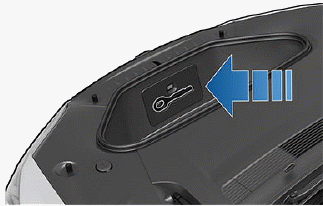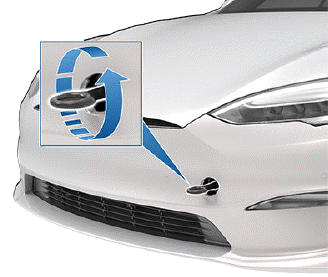Tesla Model S: Pull Onto Flatbed Truck From Front
(Using Tow Eye)
NOTE: If Model S has no low voltage power, you need an
external low voltage power supply to open the hood or
use the touchscreen. See If Vehicle Has No Power.
CAUTION: To avoid damage, only pull the vehicle
onto a flatbed truck using a properly-installed tow
eye. Using the chassis, frame, or suspension
components to pull the vehicle can result in
damage.
1. Locate the tow eye. The tow eye is located in the
front trunk.

2. Release the front tow eye cover by pressing firmly on
its top right perimeter until it pivots inward, then
gently pulling the raised section toward you.
NOTE: The front tow eye cover is connected to the
vehicle's black negative (-) terminal.

3. Fully insert the tow eye into the opening, then turn it
counter-clockwise until securely fastened.

4. Attach the winch cable to the tow eye.
CAUTION: Before pulling, make sure the tow
eye is securely tightened.
5. Activate Transport Mode.
6. Pull Model S slowly onto the flatbed truck.
READ NEXT:
NOTE: If Model S has no low voltage power, you need an
external low voltage power supply to open the hood or
use the touchscreen. See If Vehicle Has No Power.
NOTE: Vehicles equipped with a hitch re
CAUTION: To avoid damage, only pull the vehicle
onto a flatbed truck using a properly-installed tow
eye. Using the chassis, frame, or suspension
components to pull the vehicle can result in
If Model S has no low voltage power, perform the
following steps to open the hood or jump start the
auxiliary low voltage battery.
Jump Starting the Low Voltage Battery
CAUTION: Model S cannot be us
SEE MORE:
Use the scroll button on the left side of the steering yoke
to adjust the position of the mirrors and steering yoke. It
also controls the wipers and media player.
When using media player, push the button to the left
to go back to the previous song or station or push it
to the right to skip
Removal
Remove door handle for access (refer to procedure)
Remove door handle rear seal.
Remove control link pivot pin to allow control link to be
released from housing.
Position control link and remove screw securing position sensor
to link (torque 1 Nm).
Remove scr




